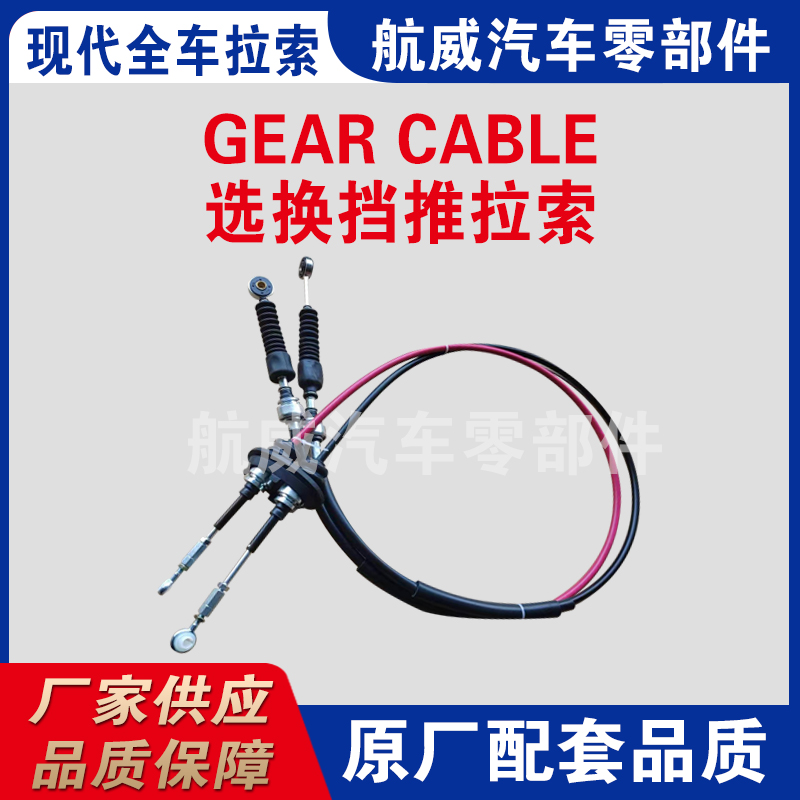Gear Cable | Stainless Steel, Precise Shifting, OEM Fit
Shift Selector Cable: A Field Guide for People Who Actually Drive
If you’ve ever felt a sloppy shifter or a delayed response from the transmission, odds are the humble Gear Cable was trying to tell you something. In the trade we call it a shift selector cable—push-pull control, Bowden assembly, take your pick—but the job is the same: translate your hand’s intention into a crisp, reliable gear change. I’ve tested more of these than I care to admit, and the best versions feel invisible. They just work.

Industry trends (and what’s not just marketing)
The trend is clear: lower friction liners, tighter bend radii, and sealed ends to keep road grit out. Automakers are pushing for longer service intervals with less NVH. Suppliers like HWEI are responding with advanced polymer liners, anti-corrosion fittings, and tighter process control. Surprisingly, many customers say the latest sealed ends reduce play noticeably after 100k km. To be honest, that tracks with what I’ve seen in fleet data.
Product snapshot: Shift Selector Cable
Origin: Qinghe County Minjiang Street south, Wuzhishan Road east. The design is straightforward: a low-friction inner core running in a reinforced conduit, with robust end fittings. It uses advanced materials and processes for smooth shifting and long life; testing and certification are in place for safety and reliability. For drivers: it just makes shifting feel right—less effort, more consistency.
| Parameter | Specification (≈ real-world may vary) |
|---|---|
| Core wire | High-tensile steel strand, polymer-coated for low μ |
| Conduit / liner | HDPE/PTFE blend liner; steel or composite wound outer |
| Operating temp | -40°C to 120°C continuous; peaks to 140°C |
| Bend radius | ≈ 120 mm min (application-dependent) |
| Service life | ≥ 200,000 shift cycles in bench tests |
| Corrosion resistance | Salt spray 240–480 h (ASTM B117 / ISO 9227) |
| End fittings | Ball joints, clevis, threaded ends; sealed boots optional |
Where a Gear Cable earns its keep
- Passenger cars and SUVs: precise selector feel, lower effort.
- Commercial trucks/buses: durability and corrosion resistance.
- Off-highway and agricultural: heavy-duty cycles, dirt sealing.
- Marine and small industrial machinery: long runs, tighter bends.
Process flow and testing (how it’s actually made)
Materials incoming QC → wire stranding → polymer coating → conduit winding → PTFE/HDPE liner insertion → end-fitting crimping and staking → boot sealing → 100% functional stroke test → friction and backlash measurement → salt-spray and thermal cycling → final inspection. Standards referenced: IATF 16949 QMS; corrosion per ASTM B117/ISO 9227; design principles aligned with DIN 71985 for Bowden systems.
Customization
Stroke length, conduit length, mounting brackets, end fittings, sealing boots, and special low-temperature liners are configurable. For EV platforms, I’ve seen OEMs specify ultra-low friction liners and compact head packaging—doable with a Gear Cable built on a PTFE-rich liner.
| Vendor | Certifications | Customization | Lead Time | Notes |
|---|---|---|---|---|
| HWEI (Qinghe County) | IATF 16949, ISO 9001 | High (ends, boots, liners, brackets) | ≈ 3–5 weeks | Strong salt-spray performance |
| Regional Assembler B | ISO 9001 | Medium | 2–4 weeks | Fast prototypes, limited liner options |
| Generic Importer A | — | Low | 1–2 weeks | Cost-led, variable QC |
Case notes (real-world)
Fleet van program: switching to sealed-end Gear Cable assemblies cut replacement rates by ~28% over 18 months. Off-highway loader: upgraded PTFE liner and stainless ends reduced shift effort by ~15% at -20°C, per operator logs.

What to check before you buy
- Stroke and routing: respect minimum bend radius.
- Backlash spec: verify at both cold and hot extremes.
- Corrosion package: ask for salt-spray hours and coating type.
- Test reports: cycle count, friction curves, thermal cycling results.
- Certs: IATF 16949 is a good sign for automotive-grade Gear Cable production.
Final thought: good cables vanish into the driving experience. This one aims for exactly that—smooth, repeatable, and quiet. Actually using it every day is the best proof.
References
- IATF 16949:2016 – Automotive Quality Management Systems.
- ISO 9227:2017 – Corrosion tests in artificial atmospheres – Salt spray tests.
- ASTM B117-19 – Standard Practice for Operating Salt Spray (Fog) Apparatus.
- DIN 71985 – Bowden control cables (design principles and calculation).
- SAE J1128 – Low Voltage Primary Cable (automotive wiring performance context).
-
Clutch Line: Braided, Leak-Proof, OEM-Grade PerformanceNewsNov.10,2025
-
Throttle Cable: Durable, Smooth Control & Universal FitNewsNov.10,2025
-
Throttle Cable: Durable, Smooth, Universal Fit, Easy InstallNewsNov.10,2025
-
Clutch Line: Durable, Leak-Proof, OEM-Grade PerformanceNewsNov.10,2025
-
Hand Brake Cable | Custom, Universal & Trailer SolutionsNewsNov.10,2025
-
Clutch Line: High-Pressure, OEM-Fit, Corrosion-ResistantNewsNov.03,2025
